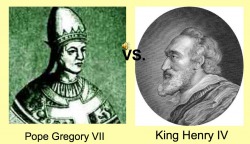Kings vs. Popes
The Power of Popes

At the top of the hierarchy, two types of leader existed: popes and kings. Kings had political power with the popes had spiritual power. They used this power to rule Europe.
Pope was the head of the Christian Church, and since most people belonged to the Church, pope held great power. Everyone was to be loyal to the pope. The pope could punish the opposed people in many way, which the most feared was the excommunication., or casting out from the church. Many people also referred to popes as their leaders, just like the king.
Pope was the head of the Christian Church, and since most people belonged to the Church, pope held great power. Everyone was to be loyal to the pope. The pope could punish the opposed people in many way, which the most feared was the excommunication., or casting out from the church. Many people also referred to popes as their leaders, just like the king.
The Power of Kings

The most powerful kings/emperors of Europe was the one of England France, and the Holy Roman Empire. Traditionally, kings of England and France inherited their throne from their father. They appeared to be able to maintain power well. Warfare was generally used in maintainance.
The Clash in the Holy Roman Empire

The situation was totally different in the Holy Roman Empire. Pope also existed in this empire rather than only the emperor. Because in the 700s, Charlemagne built this empire with the pope's approval. As the popes' power increased, they came into conflict with king. Popes thought that they should be the one to select bishops. On the other hand, kings also thought that they should be the one who was able to choose bishops. In 1073, Pope Gregory VII disapproved of a bishop selected by Emperor Henry IV. Emperor Henry then requested the authority to remove Gregory from being a pope. In response, Pope Gregory excommunicated the emperor. The emperor then begged for forgiveness, in which the pope forgave him. The pope had proved himself more powerful than the emperor. However, the fight between the popes and kings over the right to choose the bishops did not end until 1122, when the new pope and agreement came up to an agreement. They agreed that the pope could choose the bishops but would still have to obey the emperor.
Great Schism

Relations between Eastern Church and Western Church had long been embittered by political and ecclesiastical differences and theological disputes. Prominent among these were the issues of ''filioque" and the Pope's claim to universal jurisdiction. The West believed that the popes should be the leader of all churches in both East and West. The East disagreed. Pope Leo IV argued that the first pope was leader of the both east and west so all other popes should also be leader of both sides. Patriarch of Constantinople Michael Cerularius refused to say the pope was the leader. As a result, Pope Leo IX excommunicated him. This caused a complete split called the Great Schism between the Eastern (Greek) and Western (Latin) branches, which later became known as the Eastern Orthodox Church and the Roman Catholic Church, respectively.
